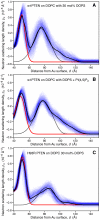Membrane association of the PTEN tumor suppressor: molecular details of the protein-membrane complex from SPR binding studies and neutron reflection
- PMID: 22505997
- PMCID: PMC3323581
- DOI: 10.1371/journal.pone.0032591
Membrane association of the PTEN tumor suppressor: molecular details of the protein-membrane complex from SPR binding studies and neutron reflection
Abstract
The structure and function of the PTEN phosphatase is investigated by studying its membrane affinity and localization on in-plane fluid, thermally disordered synthetic membrane models. The membrane association of the protein depends strongly on membrane composition, where phosphatidylserine (PS) and phosphatidylinositol diphosphate (PI(4,5)P(2)) act pronouncedly synergistic in pulling the enzyme to the membrane surface. The equilibrium dissociation constants for the binding of wild type (wt) PTEN to PS and PI(4,5)P(2) were determined to be K(d)∼12 µM and 0.4 µM, respectively, and K(d)∼50 nM if both lipids are present. Membrane affinities depend critically on membrane fluidity, which suggests multiple binding sites on the protein for PI(4,5)P(2). The PTEN mutations C124S and H93R show binding affinities that deviate strongly from those measured for the wt protein. Both mutants bind PS more strongly than wt PTEN. While C124S PTEN has at least the same affinity to PI(4,5)P(2) and an increased apparent affinity to PI(3,4,5)P(3), due to its lack of catalytic activity, H93R PTEN shows a decreased affinity to PI(4,5)P(2) and no synergy in its binding with PS and PI(4,5)P(2). Neutron reflection measurements show that the PTEN phosphatase "scoots" along the membrane surface (penetration <5 Å) but binds the membrane tightly with its two major domains, the C2 and phosphatase domains, as suggested by the crystal structure. The regulatory C-terminal tail is most likely displaced from the membrane and organized on the far side of the protein, ∼60 Å away from the bilayer surface, in a rather compact structure. The combination of binding studies and neutron reflection allows us to distinguish between PTEN mutant proteins and ultimately may identify the structural features required for membrane binding and activation of PTEN.
Conflict of interest statement
Figures





References
Publication types
MeSH terms
Substances
Grants and funding
LinkOut - more resources
Full Text Sources
Research Materials
Miscellaneous

